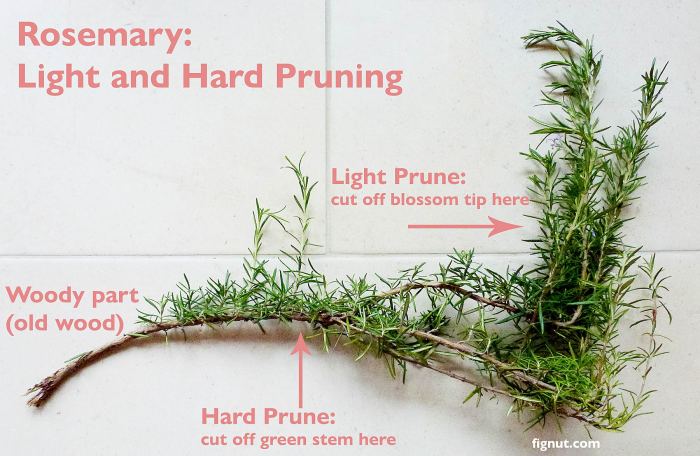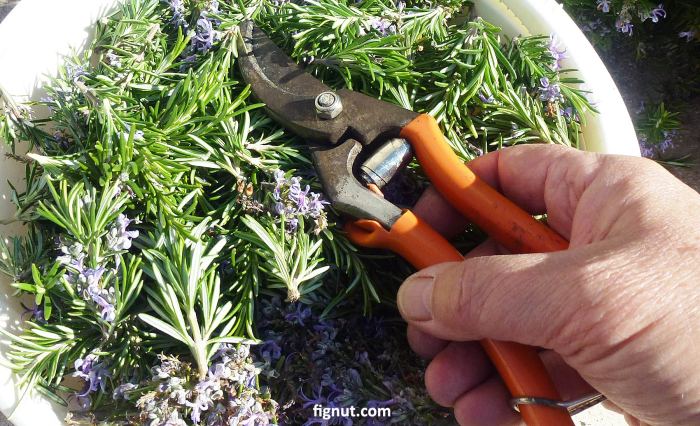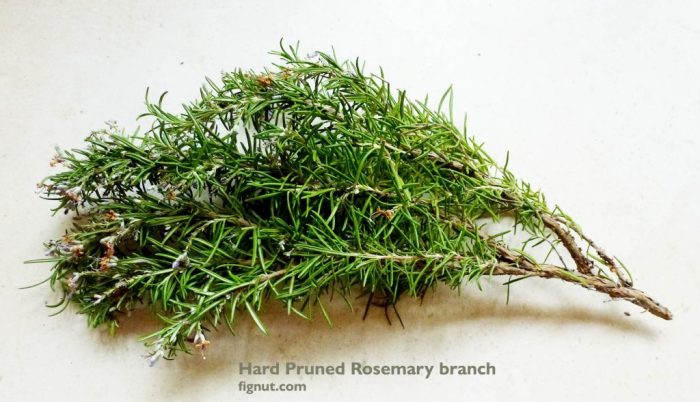How to trim rosemary plants – Embark on a journey of rosemary cultivation with our comprehensive guide to trimming techniques. Learn how to rejuvenate your plants, enhance their growth, and achieve specific goals through strategic pruning. Join us as we unravel the secrets to thriving rosemary plants, leaving you with a wealth of knowledge to nurture these aromatic wonders.
Understanding Rosemary Pruning Techniques

Rosemary plants require regular pruning to maintain their health and shape. There are several pruning methods that can be used, each with its own benefits and drawbacks. Understanding these techniques and knowing when and how to prune rosemary is essential for successful cultivation.
The most common pruning methods for rosemary plants are shearing, thinning, and shaping.
Shearing
Shearing is a technique used to trim the outer growth of rosemary plants, creating a dense and compact shape. This method is often used for hedges or topiaries. When shearing rosemary, it is important to use sharp shears and to cut back to just above a bud.
Shearing should be done regularly, typically once or twice a year, to maintain the desired shape.
Thinning
Thinning is a technique used to remove excess growth from the interior of rosemary plants. This method helps to improve air circulation and sunlight penetration, which can lead to healthier growth. When thinning rosemary, it is important to remove any dead, diseased, or crossing branches.
Thinning should be done regularly, typically once or twice a year, to maintain a healthy and productive plant.
Shaping
Shaping is a technique used to create a specific shape or form for rosemary plants. This method is often used for ornamental purposes. When shaping rosemary, it is important to use sharp shears and to carefully trim the plant to the desired shape.
Shaping should be done regularly, typically once or twice a year, to maintain the desired shape.
The benefits of regular pruning for rosemary plants include improved health, growth, and appearance. Pruning helps to remove dead, diseased, or crossing branches, which can improve air circulation and sunlight penetration. This can lead to healthier growth and increased production of rosemary leaves.
To maintain a rosemary plant’s health and shape, trimming is essential. Regular pruning encourages new growth and prevents the plant from becoming woody. Similarly, trimming basil plants involves removing the tips of the stems to promote bushier growth. For a comprehensive guide on trimming basil plants, visit how to trim basil plants . Returning to rosemary plants, trimming should be done lightly to avoid damaging the plant.
Use sharp, clean shears and cut just above a leaf node.
Pruning also helps to shape the plant and control its size, which can improve its appearance and make it more manageable.
Specific Pruning s for Rosemary Plants

Rosemary is an aromatic herb that can be grown in a variety of climates. It is a relatively low-maintenance plant, but it does require some pruning to keep it healthy and productive.
There are two main types of pruning that can be performed on rosemary plants: shaping and thinning.
Shaping Pruning
Shaping pruning is used to control the size and shape of the rosemary plant. It should be done in the spring or fall, when the plant is not actively growing.
To shape prune a rosemary plant, use sharp shears to remove any branches that are too long or that are growing in an undesirable direction. You can also use your shears to trim back any dead or diseased branches.
Thinning Pruning
Thinning pruning is used to improve the air circulation around the rosemary plant. It should be done in the summer, when the plant is actively growing.
To thin prune a rosemary plant, use sharp shears to remove any branches that are crossing or rubbing against each other. You can also use your shears to remove any branches that are growing too close to the ground.
Tips for Proper Pruning
- Use sharp shears to avoid damaging the plant.
- Make clean cuts at a 45-degree angle.
- Do not prune more than one-third of the plant at a time.
- Fertilize the plant after pruning to help it recover.
Troubleshooting Common Pruning Issues

Over-pruning or improper timing can lead to problems with rosemary plants. Over-pruning can weaken the plant and make it more susceptible to disease. Pruning at the wrong time of year can also damage the plant.
Rosemary plants, known for their fragrant leaves, require regular trimming to maintain their shape and encourage new growth. While the techniques for trimming rosemary are specific to the plant, the general principles of trimming bushes can provide guidance. For instance, how to trim the bushes advises removing dead or diseased branches, thinning out crowded areas, and shaping the plant to your desired form.
These same principles can be applied to rosemary plants, ensuring a healthy and aesthetically pleasing addition to your garden.
Pruning at the Wrong Time
Rosemary should be pruned in the spring or fall when the weather is cool and the plant is not actively growing. Pruning in the summer can stress the plant and make it more susceptible to pests and diseases.
Over-Pruning
Rosemary plants should be pruned lightly. Only remove dead or diseased branches, and trim back leggy growth by no more than one-third. Over-pruning can weaken the plant and make it more susceptible to disease.
Seek Professional Help
If you are unsure how to prune your rosemary plant, it is best to consult with a professional. A professional can help you determine the best time to prune and how much to remove.
When it comes to trimming rosemary plants, it’s essential to remove any dead or damaged stems. Similarly, when trimming raspberry plants ( how to trim raspberry plants ), it’s crucial to prune them during their dormant season. Returning to rosemary plants, regularly trimming them promotes bushier growth and helps maintain their shape.
Rosemary Pruning for Specific Purposes: How To Trim Rosemary Plants

Pruning rosemary plants is not just about removing dead or diseased branches. It’s also a way to shape the plant, encourage growth, and improve its overall health. By understanding the specific pruning techniques for rosemary, you can achieve a variety of goals, including:
Promoting Growth
To promote new growth, prune rosemary plants lightly in the spring. Remove any dead or diseased branches, as well as any branches that are crossing or rubbing against each other. You can also trim back the tips of the branches by about one-third to encourage new growth.
Improving Shape
Rosemary plants can be pruned into a variety of shapes, including topiaries, hedges, and standards. To create a topiary, prune the plant into the desired shape using sharp shears. To create a hedge, plant rosemary plants close together and prune them regularly to maintain the desired height and width.
To create a standard, prune the plant to a single trunk and remove any branches that grow below the desired height.
Encouraging Flowering
Rosemary plants flower in the spring and summer. To encourage flowering, prune the plant lightly after it has finished blooming. Remove any dead or diseased branches, as well as any branches that are crossing or rubbing against each other. You can also trim back the tips of the branches by about one-third to encourage new growth.Pruning
rosemary plants for specific purposes can transform their appearance and health. By following these simple tips, you can keep your rosemary plants looking their best and producing plenty of flowers and foliage.
Rosemary Pruning and Plant Health
Rosemary pruning is not just about shaping the plant but also about maintaining its overall health and vitality. Pruning can improve airflow around the plant, reducing the risk of disease and promoting healthy growth. It can also help to enhance the vigor of the plant, resulting in increased productivity and longevity.
Disease Prevention
Proper pruning can help to prevent diseases by removing diseased or dead branches and leaves. This reduces the amount of inoculum available to spread to healthy parts of the plant. Additionally, pruning can improve airflow around the plant, which helps to dry out the foliage and make it less hospitable to disease-causing fungi and bacteria.
Increased Vigor, How to trim rosemary plants
Pruning can also help to increase the vigor of rosemary plants. By removing old or weak branches, pruning encourages the growth of new, healthy shoots. This can lead to increased flowering and fruiting, as well as improved overall plant health.
Longevity
Proper pruning can also help to extend the lifespan of rosemary plants. By removing diseased or damaged branches, pruning helps to prevent the spread of disease and decay. Additionally, pruning can help to keep the plant from becoming overgrown and leggy, which can lead to stress and premature death.
Conclusive Thoughts
With the techniques Artikeld in this guide, you now possess the knowledge to confidently trim your rosemary plants, ensuring their health, vigor, and aesthetic appeal. Embrace the transformative power of pruning and witness the remarkable transformation of your rosemary garden.
May your plants flourish under your expert care, providing you with years of culinary and ornamental enjoyment.
Question Bank
How often should I prune my rosemary plants?
Regular pruning is essential for maintaining healthy rosemary plants. Aim to prune them lightly throughout the growing season, removing any dead or diseased branches. For more substantial pruning, perform it in late winter or early spring before new growth emerges.
What tools should I use for pruning rosemary?
Sharp, clean pruning shears are the ideal tools for rosemary pruning. Ensure they are sharp to avoid crushing or tearing the stems. Additionally, consider using gloves to protect your hands from the plant’s aromatic oils.
Can I prune rosemary plants in the summer?
While light pruning can be done throughout the growing season, it’s best to avoid major pruning during the summer months. Extensive pruning at this time can stress the plant and reduce flowering.